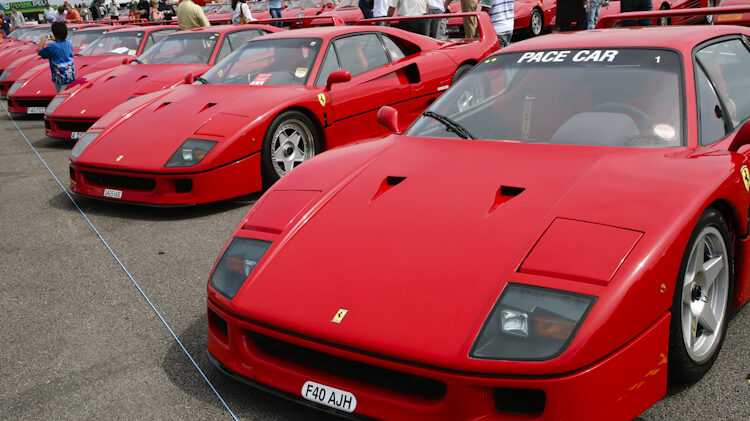Ever since Ferrari produced his first model, his cars have been well known for being fast and beautiful, whether in road or race form, but aged 90 years and aware that he did not have many years left, Enzo Ferrari called his design team together and gave them the task of creating the ‘ultimate Ferrari’.
Planned for launch in 1987, forty years after the founding of the company, the new supercar was to be known simply as, the F40.
The F40 was a no-frills, street-legal supercar that was as much at home on the track as it was on the road. Designed by Pininfarina’s Leonardo Fioravanti and fine-tuned in the windtunnel, the F40 was a development of the somewhat radical but purposeful 288 GTO Evoluzione.
Designed with aerodynamics in mind rather than excessive power, the F40 was the ultimate ‘smoothie’. Great strides were made in Formula One technology and lightweight materials during the 1980s, and Ferrari was determined to bring this advanced technology to its new supercar.
The F40’s frontal area was reduced, and the super-smooth luggage compartment lid was given a convex shape which diverted air over its surface and towards the rear wing element for maximum downforce. Two large NACA ducts dominated the front luggage compartment lid, while a deep spoiler enhanced front-end aerodynamics. The simple front end featured a shallow centre grill with side ducts for brake cooling, while the indicator and parking lights sat behind fixed clear lenses in the fenders immediately below the pop-up headlamps.
The F40 was driven by its function as a high performance supercar, its form was driven by simplicity, all of which served to propel this supercar into a new performance sphere. High-speed stability was paramount which is evidenced by the designer’s attempts to smooth the airflow over the body and to direct air towards the prominent high rear wing. The extremely ‘fast’ windscreen angle gave a roof height of just 1125mm and ensured a smooth flow of air over the body, while the undertray smoothed the underbody airflow and allowed this air to escape quickly via the rear diffusers.
The ultra-wide frontal section gave way to large exit vents for the front brakes just ahead of the recessed A-pillars. The flanks of the F40 featured two prominent NACA ducts, the large upper duct serving as the air inlet for the engine, while the lower one fed air to the rear brakes. Body lift was controlled by its front spoiler and non-adjustable rear wing, and combined with the other aero features described, these factors gave the F40 a drag co-efficient of just 0.34.

To ensure that all could enjoy the sight of the glorious Ferrari power unit, a large transparent rear plexiglass cover protected the engine but left it fully visible. Slats in the transparent engine cover and a mesh guard around the rear light clusters allowed the heat generated by the twin turbochargers to escape.
The heart of the F40 is its twin turbocharged 2.9-litre engine, which in terms of performance, would have enabled it to almost overtake the Testarossa in full flight with a gear to spare! The car’s 2936cc V8 twin (sequentially) turbocharged engine sits in a longitudinal position just behind the cabin and produced 478bhp which could power the F40 from standstill to 125mph (200km/h) in 12.5 seconds, while the 0-100km/h (62mph) dash took just 4.1 seconds. The F40 held the record as the fastest production road car in the world (1987-1989) with a top speed of 201mph (324km/h), and was the first road legal production car to break the 200mph (322km/h) barrier.
The F40 was the last car to be commissioned by Enzo Ferrari before his death on 14 August, 1988.
© Glen Smale & Virtual Motorpix

